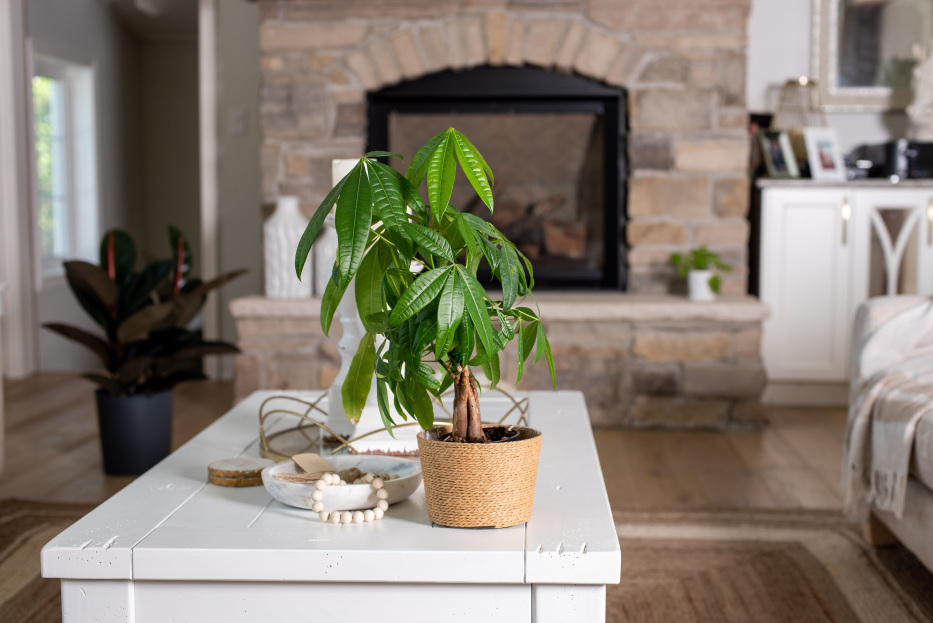
The money tree (Pachira aquatica), with its distinct braided trunk and lush green leaves, is a popular choice for indoor plant enthusiasts. Not only is it believed to bring good luck and prosperity, but it's also relatively easy to care for. In this guide, we'll dive into the essentials of nurturing a thriving money tree within the confines of your home.
Selecting the ideal spot for your money tree is the first step toward ensuring its health and growth. Money trees thrive in bright, indirect light. A location near a window with filtered sunlight or a few feet away from a sunny window would be perfect. However, avoid placing your money tree in direct sunlight, as excessive sun exposure can scorch its leaves causing damage.
Proper watering is crucial for the well-being of your money tree. Let the top few inches of the soil become fully dry before its next watering. Be cautious of overwatering, as the money tree is susceptible to root rot. Ensure that the pot has good drainage to prevent excess water from accumulating at the bottom. If watering into a pot without drainage holes, always be sure to check the bottom of the pot after watering to ensure no water collects at the bottom - which can quickly lead to root rot.
Money trees are native to tropical regions, so they appreciate a humid environment. If the air in your home is particularly dry, consider using a humidifier or placing a tray of water near the plant to increase humidity levels. Regular misting of the leaves can also help replicate their natural habitat.
When repotting be sure to select a pot that is slightly larger than the current size of your money tree's root ball. Too large of a pot can lead to overwatering and slow growth. Money trees typically need to be repotted every 2-3 years or when their roots become pot-bound. Repotting not only provides your plant with fresh soil but also allows it to grow comfortably. Gently remove the plant from its current pot, trim any excess roots, and place it in a slightly larger pot with fresh potting mix. An optimal potting mix is one that drains well, retains a bit of moisture, but doesn't get waterlogged. You can use a mix designed for tropical plants or create your own blend using peat, perlite, and pine bark.
Throughout the growth period (spring and summer), nourish your money tree with an evenly mixed liquid nutrient solution every 4-6 weeks.Reduce or stop fertilization during the colder months when the plant's growth slows down. Over-fertilization can lead to salt buildup in the soil, affecting the plant's health, so be cautious not to overdo it.
Regular pruning is essential to maintain the money tree's shape and encourage new growth. Trim back any dead, yellowing, or leggy leaves. If your plant starts to outgrow its space, you can also trim the top of the plant to encourage bushier growth. Remember to use clean and sharp pruning shears to avoid damaging the plant.
Overwatering is the #1 cause of making your money tree's stems to become mushy and soft. Let your plants soil dry out fully before watering your plant again. Be sure to remove the mushy stem and discard it. After letting the soil fully dry out, only water your plant when the top inch of soil feels fully dry to the touch. Since money tree's have trunks they can store water longer than most plants, so be sure to not overwater your plant, and only give it water when it feels fully dry.
Brown leaves on your money tree can be an indication of inconsistency with watering. This could be due to underwatering which can cause the plants to loose moisture, turn its soil hydrophobic and not allow it to absorb the water and nutrients that it needs. However overwatering can also cause brown leaves on your money tree. Overwatering can drown your plants roots causing them to develop root rot or fungal infections within its soil. It is important to determine if your plant is over watered or under watered and adjust its care first. If your plant is over watered , allow the soil to completely dry out before watering it again. Be sure to inspect its soil, root system and trunks to remove any root rot, mushy stems or address any fungal related issues first. If your plant is under watered, be sure to give it a good soak and adjust your watering routine moving forward.
Spots on your money tree leaves can be an indicator of a fungal or root related issue. It could also be scale, mealybugs, whiteflies, thrips etc. The best method is to figure out first what is wrong with your plant, whether it is an over or under-watering related issue or a pest related issue. Address this first and then continue to care and monitor your plant.
Money trees may drop leaves due to over watering, under watering, exposure to excessively hot or cold temperatures, pests or diseases, or even environmental stress.
Caring for a money tree indoors is a rewarding experience that can bring natural beauty and positive energy to your home. By supplying the appropriate levels of light, water, humidity, and care, you can guarantee that your money tree flourishes and imparts a sense of wealth to your living area. Remember, each plant is unique, so closely observe your money tree's behavior and adjust your care routine accordingly. With patience and care, your money tree will flourish and become a stunning testament to your green thumb skills.